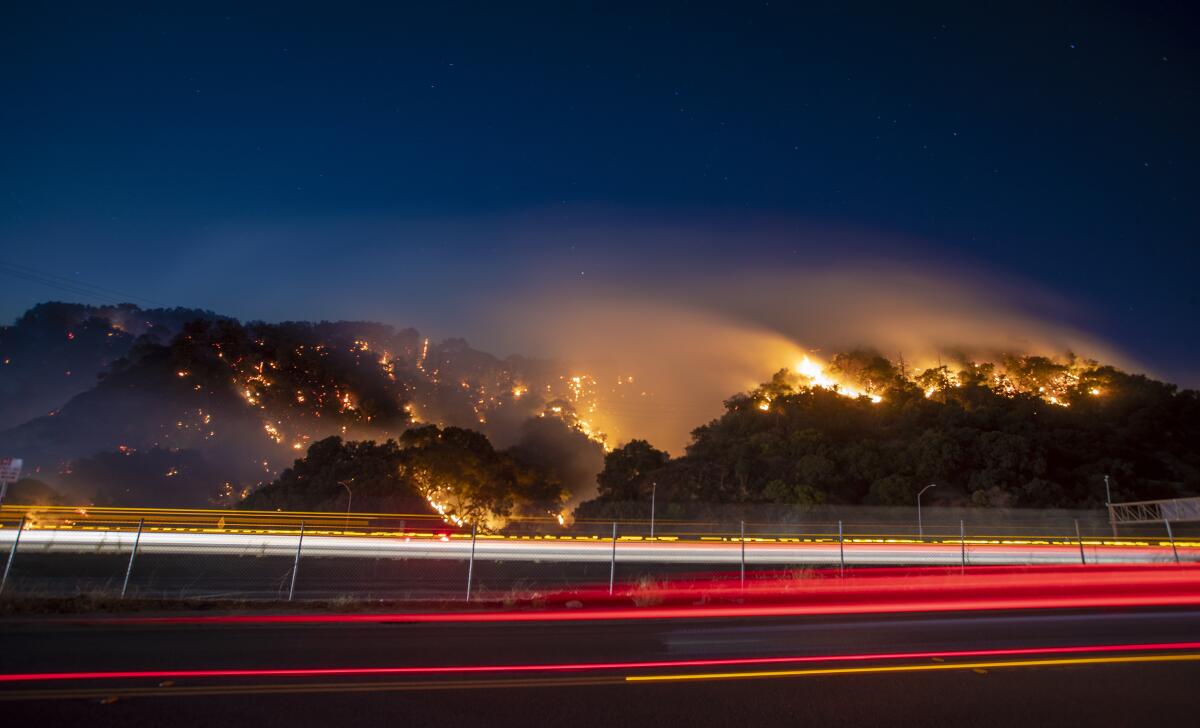Is California doing preemptive power shut-offs all wrong?

- Share via
It will be weeks, if not months, before authorities know for sure what caused the wind-driven fires that blazed through California this month.
If history is any guide, the causes are likely to be as varied as the trajectory of each fire. But at least four of the conflagrations — including the Saddleridge and Kincade fires — might have been sparked by electrical equipment malfunctioning in heavy winds despite widespread preemptive power outages that were intended to stop them.
State regulators require Pacific Gas & Electric, Southern California Edison and other for-profit power utilities to notify them of equipment malfunctions. That’s how we know that a high-voltage transmission tower malfunctioned in the approximate time and place that the Kincade fire sparked Wednesday night near Geyserville. PG&E reported a “broken jumper”on a high-voltage line that had not been de-energized, though the low-voltage distribution lines around it had been.
This weekend, PG&E reported two more incidents of malfunctioning electrical equipment close to the ignition spots of two separate fires in Lafayette in Contra Costa County.
Edison made a similar report earlier this month regarding a electrical transmission line that malfunctioned at the place where the Saddleridge fire started on Oct. 10. Witnesses reported seeing a fire at the base of the transmission tower.
It’s possible that the malfunctions were caused by the fire, not the other way around. But I wouldn’t bet on it.
Power lines and electrical equipment have been responsible for setting more than 2,000 fires since 2014, including November’s Camp fire, the deadliest wildfire in California’s recorded history. That fire was preceded by a similar report of a malfunctioning high-voltage line running through the Sierra foothills. And while authorities have still not determined the cause of the Woolsey fire, which killed three people and burned more than 1,500 structures in Los Angeles and Ventura counties, Edison reported a circuit outage at the fire’s starting point two minutes before that fire began.
If it does turn out that one or all of these recent fires were ignited by power lines, that would raise some pretty serious questions, starting with this one: Why the heck are we suffering through blackouts if they’re not stopping fires?
When the state’s electrical companies started planning preemptive shut-offs this year, Californians were told that they would be used only as a last resort to stop wildfires from igniting. That seemed reasonable, if not exactly pleasant. San Diego Gas & Electric has been using targeted power outages during fire season for a decade with great success.
But when PG&E and Edison turned out the lights this month, the decisions seemed random. Why, for instance, were the high-voltage lines near Geyserville powered up even while the surrounding distribution lines had been shut down for safety reasons?
The California Public Utilities Commission announced Monday that it was launching a formal investigation into the “public safety power shut-offs,” including an examination of the protocols the utilities used to decide when and how to shut off power. That’s good because Californians deserve to know if these blackouts are accomplishing anything other cutting power just when people need it to get news of evacuations, to filter out fire-polluted air or to open the garage door in order to get the car out and flee fast-moving flames.
The human, financial and environmental costs of the state’s unprecedented preventive power outages are likely to be staggering by any measure — thousands of fridges filled with spoiled food and medicine, lost paychecks from shuttered businesses, people hurt in accidents caused by traffic light outages, and untold amounts of greenhouse gasses spewed by diesel and gasoline generators. We deserve to know if those costs have bought us any real safety.
More to Read
A cure for the common opinion
Get thought-provoking perspectives with our weekly newsletter.
You may occasionally receive promotional content from the Los Angeles Times.










